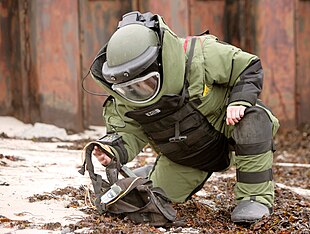
Back بذلة قنابل Arabic Traje antiexplosivos Spanish لباس بمب Persian 対爆スーツ Japanese 방폭복 Korean Bomb disposal suit SIMPLE Bombna obleka Slovenian Bombdräkt Swedish บอมบ์สูท Thai Вибухозахисний костюм Ukrainian

A bomb suit, Explosive Ordnance Disposal (EOD) suit or a blast suit is a heavy suit of body armor designed to withstand the pressure generated by a bomb and any fragments the bomb may produce.[1][2][3] It is usually worn by trained personnel attempting bomb disposal. In contrast to ballistic body armors, which usually focus on protecting the torso and head, a bomb suit must protect all parts of the body, since the dangers posed by a bomb's explosion affect the entire body.
Parts of the bomb suit overlap for maximum protection. The suit protects in several different ways. It deflects or stops projectiles that may come from an exploded device. It also stops or greatly decreases the pressure of the blast wave being transmitted to the person inside of the suit. Most bomb suits, such as the Advanced Bomb Suit, use layers of Kevlar, foam, and plastic to accomplish these functions.
In order to maximize protection, bomb suits come with a pair of interchangeable gloves and wrist guard attachments. This gives the wearer's hands mobility and protection needed for the task and avoid cross contamination of any evidence found (e.g., fingerprints).
EOD technicians wear bomb suits during reconnaissance, "render safe" or disruption procedures on potential or confirmed explosive threats. Such suits must provide a tremendous degree of protection from fragmentation, blast overpressure, thermal and tertiary effects should the threat device detonate. At the same time, the suit can significantly hinder their mobility or situational awareness.
- ^ Stewart, Ian B.; Stewart, Kelly L.; Worringham, Charles J.; Costello, Joseph T. (2014-02-21). "Physiological Tolerance Times while Wearing Explosive Ordnance Disposal Protective Clothing in Simulated Environmental Extremes". PLOS ONE. 9 (2): e83740. Bibcode:2014PLoSO...983740S. doi:10.1371/journal.pone.0083740. PMC 3931617. PMID 24586228.
- ^ Costello, Joseph T.; Stewart, Kelly L.; Stewart, Ian B. (2015-08-01). "Inside the 'Hurt Locker': The Combined Effects of Explosive Ordnance Disposal and Chemical Protective Clothing on Physiological Tolerance Time in Extreme Environments". The Annals of Occupational Hygiene. 59 (7): 922–931. doi:10.1093/annhyg/mev029. ISSN 1475-3162. PMC 4580838. PMID 25878167.
- ^ Costello, Joseph T.; Stewart, Kelly L.; Stewart, Ian B. (2015-01-01). "The effects of metabolic work rate and ambient environment on physiological tolerance times while wearing explosive and chemical personal protective equipment". BioMed Research International. 2015: 857536. doi:10.1155/2015/857536. ISSN 2314-6141. PMC 4383354. PMID 25866818.